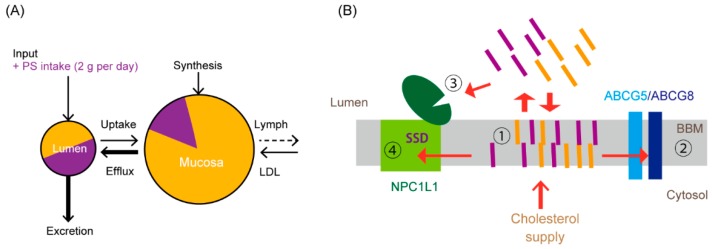Figure 5.
(A) Changes in cholesterol flux with plant sterol/stanol (PS) intake are shown in a simplified open compartment model in Figure 1F. Two grams of PS per day, which is recommended to reduce circulating LDL-C, could predominate in luminal sterols and is incorporated into the BBM (Mucosa). Lumen indicates the ratio of cholesterol to PS as 1:1, because approximately 2 g of cholesterol is supplied to the intestinal lumen per day in humans [15]. PS stimulates efflux, thus increasing total fecal neutral sterol excretion. These increased pathways are shown in bold arrows. PS in the mucosa and the lumen is indicated in purple as an image. (B) Possible effective sites of PSs for cholesterol absorption inhibition. The possible sites are indicated as ① to ④ in the figure. ①, cholesterol (yellow bars) and PSs (purple bars) are taken up by the BBM, where the sterol capacity is limited. ②, ABCG5/G8 accepts both substrates [98]. ABCG5/G8 might be activated by PSs [54,97,99,100] and efflux more cholesterol concomitantly. ③, PSs might dilute cholesterol at the surface of the mucosa, reducing the chance to access to the binding site in the N-terminal domain of NPC1L1. ④, PSs can be mixed with cholesterol in the BBM, reducing the abundance of cholesterol in it and preventing the sterol-sensing domain (SSD) of NPC1L1 from sensing an increase in cholesterol. PSs may also compete with cholesterol for the binding site of the SSD.

